
| |||||||
July 28, 1999
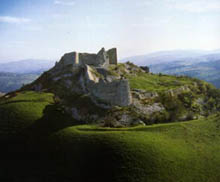 Novo brdo hill |
The city at the times we are living in, i.e. by the end of the twentieth century or to be more precise at the end of the millennium, surely is a unique conception. Simultaneously, the city is the world on a small scale, but the planet has almost become a city. To watch the development of a city as a settlement from the fortresses of the old world to the modern megalopolises would take too much of the author's time (an entire decade, perhaps), so we will halt and examine an interesting example of the Medieval Serbia.
Namely, in these days when from different CITIES throughout the world messages arrive to Belgrade, of miscellaneous content (from commendations to threats), the citizens of Serbia (and Belgrade itself, that has grown on the ruins of the Celtic settlement built at the mouth of the River of Sava and the River of Danube at least 3000 years ago), are rightly wondering where does this all come from?! New York, London�
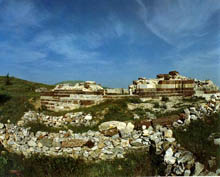
|
Lacking evil intentions, the citizens of Serbia are wondering, already tired by many a year's threats (regrettable the messages containing these were dominant in the immediate past of this part of the world), where do these messages come from? The messages are coming from the CITIES that either did not exist or were just small settlements at the time people in these areas lived in urbane conditions of the times. In order to avoid confusion, we are talking about the Middle Age period or to be more precise about the period following the second half of the 13th century till the year 1459 when the Medieval Serbian state ceased to exist (in Bosnia till the year 1463).
We shall dwell only upon one example of the medieval CITY, that was never capital city of any ruler from that time.
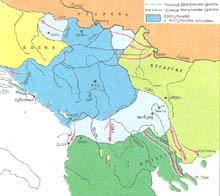
Serbia in King Milutin's epoch |
Novo Brdo in the medieval zhupa (district) of Toplica, today named Kriva Reka in Kosovo was one of the most important CITIES of its times in the southeastern Europe. For the sake of the wider reading public we wish to point out that this was the period of the Middle Age, at the time London was at the stage of growing and had far smaller number of citizens, but was already the state capital city (since the 9th century). Novo Brdo was the center of trading, mining and caravan roads. As was the case with many cities at that time, it had firm walls and a suburb (suburbium), its military crew, the Commander of the city and all the administrative factors directing the relations within the city, as well as the entire way of living.
Mining was the main activity in Novo Brdo. The CITY was renowned for its production of silver and silver ore with gold ingredients. The Serbian rulers have more often forged coins than practiced selling silver and gold in the markets. The presence of "Sasses" (Germans) (surely before the year of 1254) has remarkably improved both mining and processing of ore. The CITY itself had its own Law - The Novo Brdo Statute. By this Law, all the relations within the city were regulated. The City Council or the "Council of purgars" was the main legal body of the city self-rule, and in certain sense (of the time), it had a form of autonomy. There were 12 members of the Council. The Council took care of administration, prices, and ways of selling different goods but also of the communal matters of the CITY itself. The "Novo Brdo Law" from the year of 1412 contains all this, as well as all the other important regulations, the same as does the "Mining Law" of Despot (Prince) Stefan Lazarevic. Thus, Novo Brdo had completely defined relation within the city itself but also the relations with the outer world. We are again, just for the sake of the reading public, pointing out that this was the time when, for example, London was in the course of becoming the administrative center of the state (under the rule of Edward the Third - 14th century) or, if there is someone more acquainted with the times when the important works of the world literature as Decameron and Hell came into being, this is also the time when the University of Sorbonne was founded but also the time when the Turkish hordes were forcing their way to Europe and driving the Byzantium out of the Asian soil forever.
The second important aspect of Novo Brdo's existence was trading. Serbia mostly exported: honey, cheese, leather, fur, ready-made home made articles, and imported: fruit from the South, best kinds of Mediterranean vines, costly fabrics and adornments made of fine materials. The prices were precisely given by the Law, as well as the ways and terms of sale. The trading was accompanied by numerous crafts, all present at the CITY (tailors, bakers, butchers, forgers, jewelers etc.)
Coins were also forged in Novo Brdo. At the time of King Milutin (1282-1321) from the Nemanjic dynasty, silver coins were forged that were in demand even far beyond the boundaries of Milutin's state. The then Serbian money was known by the name of "grosh" (grossus) or, more often as the "dinar" (denarii). It was of extreme fineness and had the same weight as the Venetian coins - 2.178 grams. This currency was often used in the transactions of the Raguse (Dubrovnik) and Venetian and other traders. The legation consisting of three Ragusean and one Venetian traders in Novo Brdo received the Charter (hrisovulja) from the Emperor Dushan (1331-1355) on special trading privileges for the City-Republic of Raguse (Dubrovnik).
Novo Brdo, being the important center of all the mentioned activities was situated at a busy road, leading to the shores of the Adriatic Sea, passing Zeta, the River of Ibar to Pristina and from there to Novo Brdo itself. We will point out that this was just one of tens of busy roads used then in the Medieval Serbian State.
As the CITY fell under the Turkish rule, its manufacture and soon afterward the life itself faded away. Europe was spared and stepped into the Renaissance using all the advantages of the Byzantine settlements, inherited also by Medieval Serbia. Today, from the west side, miscellaneous, already mentioned messages are arriving to Serbia. Still the citizens of this part of the Balkans are wondering, from which CITIES and why?!
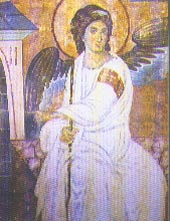
|
Did you know that on August 21, 1958, during the first television transmission from Europe to America, on the TV sets at the North American continent appeared the picture of the "White Angel" fresco from the Mileseva Monastery, near Prijepolje? This was the beginning of the satellite television era. The Mileseva Monastery was founded by King Vladislav, the son of the King Stefan Prvovencani and the grandson of Stefan Nemanja, the founder of the Nemanjic Dynasty that brought progress to the Serbian mediaeval state. The old biographers tell that King Vladislav started building the church as soon as he took the throne, meaning following the year of 1234. Some of the details that could be noted in the frescoes in the church testify that the church could have been built even ten years earlier, at the time King Vladislav was only a Prince and ruled the Zhupa of Crna Stena. The building of the monastery could probably be placed between the years of 1219 and 1235. King Vladislav died in the 13th century seventies and was buried in Mileseva, his bequest.
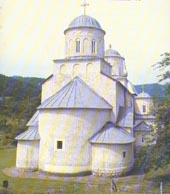
|
The Monastery was built in the then architectural style of Raska School, characteristic for the buildings of the 12th and 13th century in the mediaeval Serbian State. The prevailing attributes of this style were simplicity and romanesque. Originally, the church had one cupola, and in later reconstructions another one was added. From the interior portal, built probably following the example of Studenica, only one stone lion, rather rustically carved, was saved.
Around the year of 1235, another outer parvis was added, built by King Vladislav to bury his uncle, the first Serbian Archbishop Sava (Rastko Nemanjic, son of Stefan Nemanja and brother of Stefan Prvovencani). Archbishop Sava secured the self-government of the Serbian Orthodox Church (autocephalous) in Nicaea (then the centre of the Byzantine Empire, since Constantinople was captured by the soldiers of the Forth Crusade toward the East in 1204). After his death, the Church declared him a saint and to these days, the name of Steve Sava is known to all of the Serbian people.
A special path of faith and behavior that Archbishop Sava followed is today known as "svetosavlje"2. Svetosavlje is more than just faith and churchgoing among the Serbs; it is a way of behaving and a complete philosophy of life. In the church is the most renowned and probably the most accurate portrait of St. Sava. In 1595 Sinan Pasha took the St. Sava relics from the monastery and burned them down in Belgrade. In doing this, he had two objectives: to punish the Serbs for the their uprising a year before (1594) and to pull out the roots of belief the Moslems had started to follow. In essence, as a writer once said, Sinan Pasha wanted to send St. Sava to "to the ashes", but in fact sent him into the eternity.
On the importance of the monastery itself speaks the fact that in 1377 the Bosnian King Tvrtko the First Kotromanin was crowned, as the King of Bosnia and Serbia. In 1446, Stefan Vuksic Kosaca, the ruler of Zahumlje, took the title of "Herzog of St. Sava". During the centuries that followed, the monastery met many vicissitudes. In 1627, the monks addressed a letter to the Russian Emperor Mikhail asking for help in reconstructing the monastery roof. They said that because of the dilapidated roof, most of the frescoes and mosaics might get damaged, many of them having elements of gold. In 1857, the Russian writer Hilverding in his book describing his travels recorded that the church is in ruins, that there is no roof and that the cupolas are holding on parts of the ceiling only. In 1863, the church was reconstructed with the help of the citizens of Prijepolje. The Mileseva Monastery has always shared the fate of the Serbian people throughout the time.
The murals of Mileseva Monastery represent masterpieces of the Serbian mediaeval painting. The fresco of "The Angel at the Christ's grave" (The White Angel") is certainly the most renowned in this monastery. It shows a biblical scene where the Angel is addressing the people present wishing to tell them that the one who is alive should not be looked for among the dead. However, the rest of the frescoes representing scenes from the Bible should not be forgotten. Surely among the most important frescoes of the complete achievements in the medieval Serbia's painting are the portraits of Stefan Nemanja (Simeon), St. Sava, King Stefan Prvovencani, King Radoslav and two portraits of King Vladislav.
In the history of Serbian people the Mileseva Monastery will be recorded for another important activity. Namely, in 1544 at the monastery the second printing shop in Serbia started working (the first one was in Obod, in Cetinje). It operated in secrecy, spiting the Turkish authorities for the full thirteen years. Only 89 years after Gutenberg invented the printing technology, the books were printed there in spite of all the unfavorable circumstances.
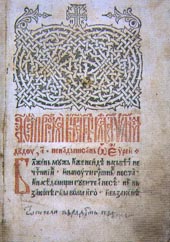
|
The Mileseva Monastery is situated near Prijepolje, the place between the two rivers, Milesevka and Lim, at the crossing from Serbia to Montenegro. Numerous findings prove that Prijepolje was a rather important small town during the Roman and late antique epoch. Some of the findings testify that high dignitaries of the Empire stayed there from the second till the fourth century. In the village of Izbisnje, 9 km north of Prijepolje even today remains the inscription testifying to the importance and grandness of the city, reading: ' All these buildings, erected with great efforts, that you are looking at: the walls, temples, houses, fountains, stables, atriums, baths, all these, with the help of Christ in a few years were built by the Episcope Stefan, during the Emperor Justin's reign." This inscription originates from between the years of 527 and 565.
In the Middle Age, at the time of Nemanjic dynasty, numerous monasteries were built in Polimlje, and Prijepolje played an important role as the trading and the centre of caravan roads. Many traders, from Dubrovnik, but also from more distant places (Venice) as well as from the whole coastal area of the Adriatic Sea, came to Prijepolje or visited it on their way to other cities of the mediaeval Serbia. From Dubrovnik, Kotor or Skadar, via Trebinje and Onogost, the international routes of the time reached the valley of Prijepolje. From there, the travelers journeyed further towards Novi Pazar and via Mitrovica, Lipljan, Skopje and Sofia to Tzarigrad (Constantinople). The citizens of Prijepolje were engaged in organizing the traffic and numerous crafts, as well as in trading. A large number of Prijepolje citizens went to Dubrovnik get educated and to acquire artisanship skills, especially between 1373 and 1378.
During the time of the Turkish rule, Prijepolje shared the fate not only of Serbia but also of the entire Balkans. From this part of the country, many a renowned person has risen, not only locally. The Grand Vizier Mehmed Pasha Sokolovic, as well as his brother Macarius come from the area of Prijepolje. The greatest merit of Mehmed Pasha was the renewal of the Pec Patriarchate and its continued uninterrupted activity (16th century) . His brother was the first Patriarch of the re-established Patriarchate.
In the later centuries, numerous uprisings and rebellions were recorded in these parts, and the participation of Prijepolje citizens in all the wars waged in the 20th century was recorded. In 1912-1913, Sreten Vukosavljevic founded the First Komita Volunteers' unit in the area. 1.643 soldiers from Prijepolje went to World War One (1914-1918) with only 301 survivors.
In the Second World War (1941-1945), Prijepolje again lost many lives. With the German's attack in December 1943, this is where the sixth offensive started, one of the fiercest warring in these parts. The historians use to say:"Whenever there was a gunfire in the Balkans, between Prijepolje and Plevlje, on Jabuka, there was a soldier, since this is an important military strategic pass between the Podrinje and Polimlje corridor."
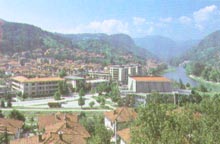
|
Prijepolje and its surroundings were not only warring, although this is, mainly, the fate of the Balkans and of Serbia. There was an important cultural activity in Prijepolje between the two World Wars. Already in 1914, a high school was founded in Prijepolje, and in 1932, the newspaper "Sandzak" was published, often changing its name, but not its aim. As the editors set out, the aim of the newspaper was the progress of culture and economy. Today in Prijepolje they have the "Polimlje" newspaper. In the above-mentioned year of 1932, the then young artist-painter Prvoslav Pivo Karamatijevic had his first exhibition. There were numerous cultural and social activities going on in the period between the wars.
Since 1951 in Prijepolje the textile industry has been developed, as well as shoes factory, chemical plant and metal plant. The city is situated at the halfway mark of the Belgrade-Bar railway line. In the last decade of the 20th century, Prijepolje took on a specific burden of giving shelter to numerous Moslems and Serbs - refugees from Bosnia and Herzegovina.
Thus Prijepolje, and Serbia with it, presented the world with "The White Angel" from the beginning of this story. The same world presented Prijepolje and Serbia with "The Guardian Angel". How is that for an exchange?
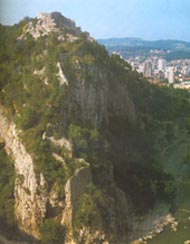
|
Uzice (Uzhice) is a city in western Serbia, 224 km. away from Belgrade. The river of Djetina is running through the city. The city is situated at the foot of the Zlatibor Mountain, which is abundant with woods, rippled pastures and intersected in several places by creeks and brooks. From the ancient times, many roads have been leading near or over this mountain. The closeness of the River of Drina makes this area especially attractive. At the Zlatibor Mountain peak, the Mediterranean and continental air currents cross, making this mountain a climatic health resort.
In the vicinity of the city is the village of Stapari where the remnants of material culture from the early Stone Age (ceramics, tools and weapons)were found. The remnants of the material culture prove that even in the Iron Age the place was lively.
The period of the Roman rule in the territory of the present western Serbia was marked by great progress of the local population. At that time, Uzice was the intersection of important roads. Within the Roman Empire administration, Uzice was the part of the Illyric Province.
During the Great Migration, the Huns have looted it.
The city has got its present name (from 1945 to the middle nineties it was named Titovo Uzice) with the arrival of Slavs to the Balkan Peninsula. The abundance of similar toponyms across the European Continent in the territory occupied then and today by the Slavic peoples, testifies to the Slavic (to be more exact, Serbian) name of the city. The city was most probably named by the same name since the initial settlement of Serbs, but the first written recording of the city dates from the 14th century (on October 9, 1329 the name of the city was first recorded in a Dubrovnik Administration debit- entry).
After the break up of the centralized Nemanjic Dynasty State, the city of Uzice came under the rule of the County Lord Nikola Altomanovic (1366 - 1373). It was his capital city. Nikola Altomanovic was defeated by Knez Lazar and the Bosnian King Tvrtko and at that moment Uzice became a part of Lazar's State. The connections to Dubrovnik became stronger and the name of the city could be found in the numerous Dubrovnik Administration charters. One of the most important mediaeval roads of trade in the western Balkan Peninsula led from Uzice (Dubrovnik, Visegrad, Dobruna, Cargan, Kremna, Vrutak, Stapari, Sinjevac, Uzice and further on towards the North and the East).
In 1463, Uzice came under the Turkish rule and was heavily destroyed. But recognizing the importance of the city, the Turks restored it in short time. In the 16th century, the city again progressed as it was progressing during the Nemanjic's state. At that time, it became the permanent Dubrovnik colony in that part of the Turkish Empire.
Besides trading, the educational and cultural activities rapidly developed in the city. In the 16th century, there was a printing shop in the Rujno monastery.
There is a record that in Uzice in the 17th century there were 400 shops, many khans, caravansaries and mosques. Numerous were also schools then opened in the city and it was recorded that many learned people had then stayed in or passed through the city. Such was the importance of the city (it was second by size only to Belgrade) that the folklore songs called it "the Little Tzarigrad (Constantinople)"
The Turks were defeated near Vienna in 1863 and in withdrawing, had temporarily vacated Uzice as well. The Austrians occupied it temporarily. During the next war between Austria and Turkey (1737), the city was heavily destroyed.
During the First Serbian Insurrection (1804), in 1805, the fights for the city began. During an onslaught against the walls of the city, one of the insurrectionist army commanders Milos Obrenovic (later the leader of the Second Serbian Insurrection) was seriously wounded. The Serbs had taken over the city in 1807, during the siege led by Lazar Mutap.
The Great powers decided that the Turks should leave the city in 1863. While leaving the city, the Turks ruined it. Later the city was reconstructed and from this moment on the city began to develop in modern terms and intensively change its appearance and size.
During the Serbian-Turkish War (1876) there was a hospital in Uzice.
The workers movement has been progressing in the city from 1903. One of the workers movement leaders was the renowned leader of the socialists Dimitije Tucovic, whose party was the only party to vote against the approving of war credits at the international meeting of related political parties in the wake of World War One. Dimitrije Tucovic lost his life as the Kingdom Of Serbia Army reserve officer in World War One (1914-1918). In World War One and both the Balkans' Wars (1912 and 1913) a large number of citizens of Uzice took part.
In 1839, a high school was founded in the city and the high school newspaper "Napredak (Progress)" was founded.
At the very beginning of the Second World War (1941 - 1945), on September 24, 1941 the National Liberation Movement units liberated the city and the so-called "Uzice Republic" was founded. This was the first free territory in Europe. All the bodies of the civil and army administration were formed, and the National Liberation Movement Supreme Command headquarters were moved into the city. The Uzice Republic" lasted till the end of November 1941.
After the country was liberated from the German rule, Uzice progressed rapidly and the number of the citizens raised. The most important industrial facilities are, by all means, the Sevojno copper mill (one of the biggest in Europe) and "Prvi Partizan" the tools and plumbing installations factory.
One of the most important activities in this area is tourism. Zlatibor iz a health resort and health tourism and organized medical treatment have a great role. Winter tourism is also advanced since there are appropriate terrains for all kinds of winter sports.
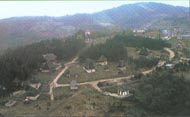
|
An especial attraction in this area is Staro selo in Sirogojno. This is the so-called "museum in the open ". This settlement consists of authentic objects from the end of the 18th, 19th and the beginning of the 20th century. Objects representing the accommodation culture of the Zlatibor area are concentrated at the Staro selo location.
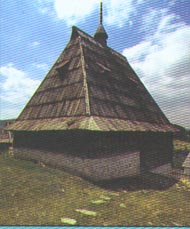
|
All the houses from the surrounding area were moved into one place and made into the model of an original Serbian village of this territory (mountain type of settlement)
The Zlatibor log cabin is the most perfect type of the mountain house in Serbia. All the objects, both the housing and the economy ones, (water mills), as well the objects for keeping the domestic animals were made by the home self-skilled artisans. The folk construction in this area was advanced through centuries. One (always numerous) family, beside the main building with the main entrance always looking eastward and the back door looking westward, had a much complicated and specific farmstead, consisting of numerous objects with specific purpose depending on the needs.
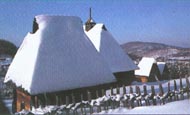
|
Each son of a family was given a separate house to live in. In the evenings, the whole family gathered in the main house, around the open fireplace. At the roof, there were especially made ventilation holes to let the smoke out, the so-called "badza". In the heated room, by the earthen hearth, the eldest members of the family and the youngest children slept.
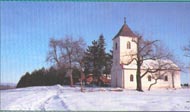
|
Nearby is the St. Peter and Paul Church built in 1764. The founder was Georgije Smiljanic, the archpriest. The wooden hall of the church was replaced by a brick one in the 19th century, and a bell tower was built (present appearance)
Sirogojno is renowned worldwide by unique hand-knitted sweaters. The sweaters are knitted by women villagers in patterns created by Dobrila Vasiljevic-Smiljanic. There is a standing exhibition in the village and the hand-made objects - unique items - could be bought.
Sirogojno, being the unique monument of the Serbian people's culture maintained to keep its beauty in spite of numerous wars and destroying. Luckily for all the lovers of antiquities and folklore, the village stayed untouched during the NATO aggression against Yugoslavia, although Uzice was attacked almost daily during the 78 days of the aggression and heavily destroyed.
[ Home | Encyclopedia | Facts&Figures | News ]
Copyright © 1998, 1999 Ministry of Information
Email: mirs@srbija-info.yu